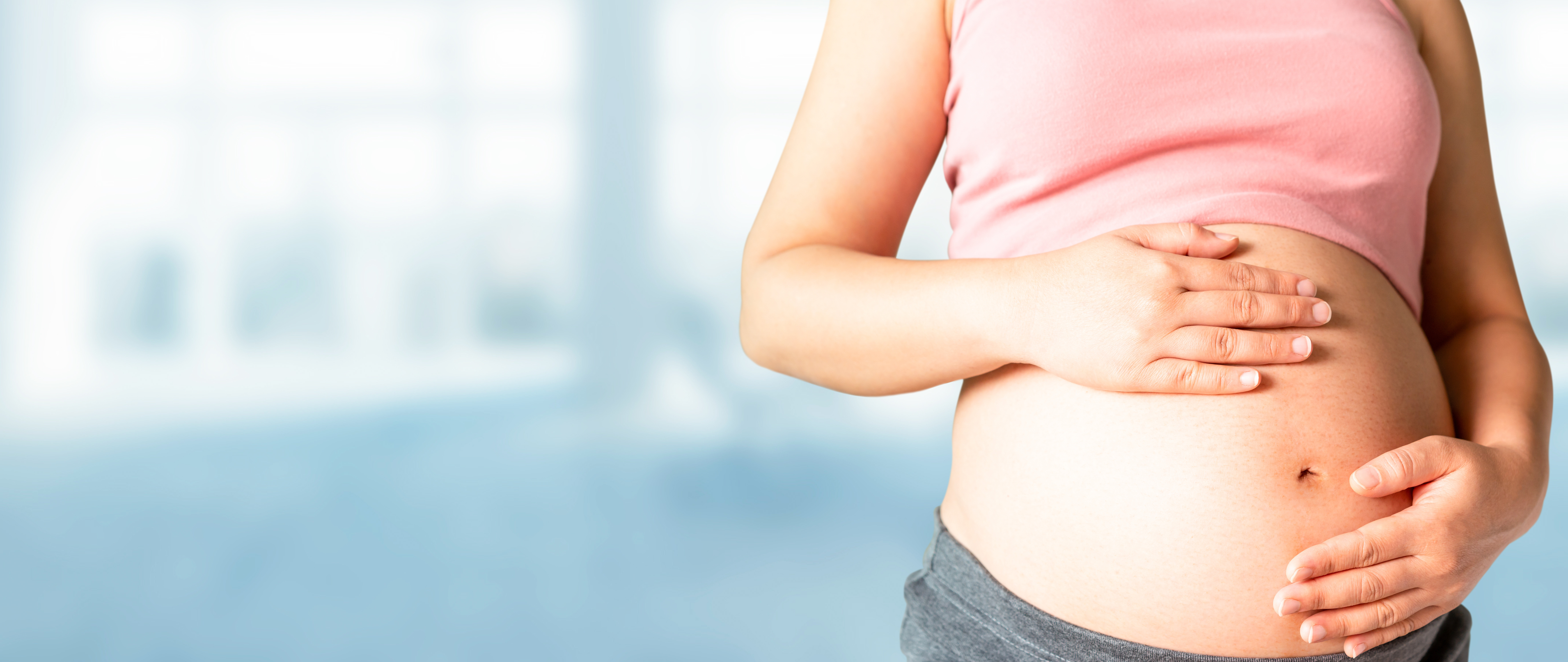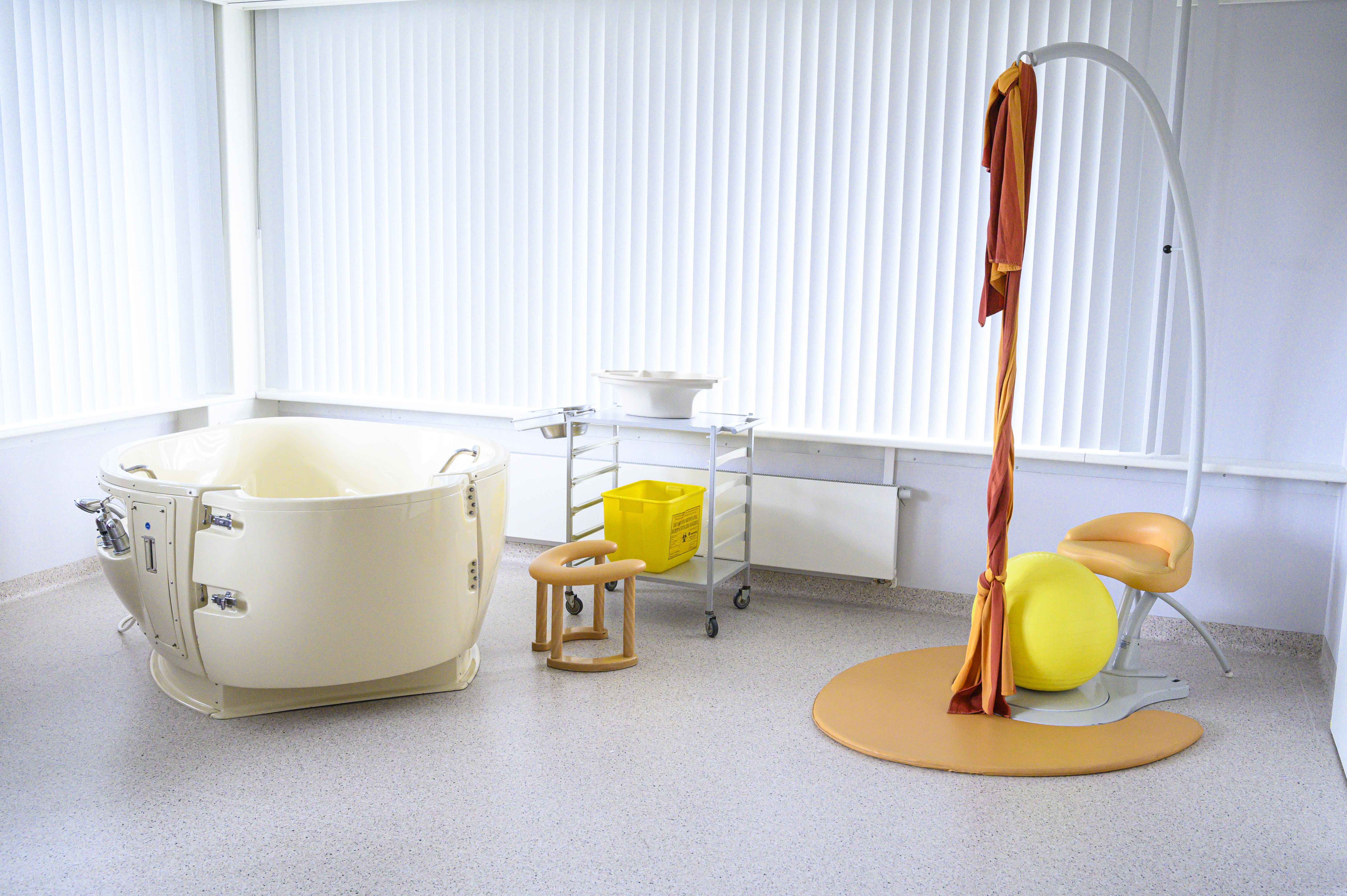
Childbirth
Please note
The info on this page only applies to patients giving birth at St Vincent General Hospital in Deinze.
Your admission
Your admissionIt is often difficult to distinguish between hard bellies and real contractions. Hard bellies are common in the last trimester of pregnancy. However, these are only a temporary and painless tightening of the uterus. Contractions are more painful, follow each other faster and faster and gradually become more regular. That is when talk about being 'in labour'.
It is best to come to the delivery unit when you:
- get regular, painfulcontractions. Feel free to take another bath or shower if your waters have not broken and you are unsure if you are really in labour. If the contractions do not stop after taking a bath and come back regularly and painfully every five minutes (for a first baby) or every 10 minutes (for a second, third... baby), it is time to come to the maternity unit.
- lose amniotic fluid with or without contractions (drop by drop or in a wave.) Amniotic fluid, unlike urine, cannot be held up. It is watery, odourless, usually clear and sometimes somewhat white flaky. If the amniotic fluid has a dark colour (stool), come to the maternity unit immediately.
- notice an alarming reduction in child movements.
- lose blood. Sometimes you can have a little brown loss after a vaginal examination, without it being a problem. In case of a bright red blood loss, you should come to the maternity unit immediately.
- get apersistent headache and/or pain in the stomach area, see black spots in front of the eyes or have abnormal abdominal pain
- are uncertain or worried about something.
If you are uncertain or worried, you can always contact the maternity unit by phone: +32 (0)9 387 72 50. A midwife is present day and night to advise and assist you.
General
- identity card
- blood type card
- pregnancy log
- marriage certificate or acknowledgement form
- signed (admission) forms
- nursing bras
- personal toiletries
- pyjamas or tracksuit for postnatal daywear (for discharge)
For the baby
- clothes, camisoles, hat to go home (during the maternity stay, you can use the hospital's clothes free of charge)
- socks and scratch mittens
- breastfeeding cushion
By day
- at reception: the receptionist notifies the maternity unit and a midwife comes to pick you up from reception.
- at the maternity unit: the head midwife will accompany you to the delivery unit.
at night (between 9.30pm and 6am)
- to the Emergency Unit: if you ring the bell there, the night nurse from the Emergency Unit will escort you to the delivery unit.
If you arrive at the maternity unit yourself and find no one at the desk, you can summon the midwife in charge by pressing the bell at the maternity unit or delivery unit desk.
Childbirth
ChildbirthHuiselijke sfeer
De hele arbeids- en verloskamer is op die manier ingericht dat ze zo vertrouwd mogelijk overkomt. We besteden bijzonder veel aandacht aan het creëren van een huiselijke sfeer omdat we het belangrijk vinden dat je je comfortabel voelt tijdens de arbeid en bevalling, hetgeen op zichzelf al een ontspannende werking heeft.
Tijdens de weeën zullen de vroedvrouwen je helpen om met de pijn om te gaan. Het is daarbij belangrijk dat je in beweging blijft en steeds andere houdingen probeert. Een massage door je partner, het gebruik van water, je lievelingsmuziek, aangepast sfeerlicht … kunnen wonderen doen. Je kan er tijdens de arbeid ook voor kiezen om te relaxeren in het bad als er geen medische tegenindicaties zijn.

Professionele begeleiding
De vroedvrouwen zullen je begeleiden doorheen de hele arbeid. Ze reiken tips aan en helpen om (pijnlijke) weeën zo goed mogelijk op te vangen. Ze nemen ook de medische opvolging tijdens de arbeid voor hun rekening. De vroedvrouwen gaan daarbij voortdurend in overleg met je gynaecoloog.
In onze materniteit kan je kiezen om liggend of rechtzittend te bevallen op het verlosbed. Je kan ook, ondersteund door je partner, rechtzittend bevallen op een bevallingskruk.
Een onderwaterbevalling behoort ook tot de mogelijkheden als er geen medische tegenindicaties zijn. Het warme water werkt ontspannend, de arbeid verloopt over het algemeen vlotter en de weeën worden als minder pijnlijk ervaren doordat de huid in het warme water zacht en soepel wordt. Ook voor de baby blijkt een onderwatergeboorte een minder traumatische ervaring te zijn. De overgang van de moederbuik naar het water van het bad – met ongeveer dezelfde temperatuur en waar geluid en licht nog eventjes gedempt blijven – verloopt veel minder bruusk.
Als toekomstige ouders hoef je geen schrik te hebben dat de baby verdrinkt, want zolang het bloed nog via de navelstreng naar de baby stroomt, hoeft hij of zij nog niet zelfstandig te ademen om voldoende zuurstof te krijgen.
Skin-to-skin
Na de bevalling zal je baby onmiddellijk bij jou op de buik worden gelegd. Dit skin-to-skin moment is heel belangrijk in de verdere ontwikkeling van je baby. De kinderarts zal vervolgens je baby onderzoeken en de vroedvrouwen zullen je geleidelijk aan aanleren hoe je zelfstandig kan instaan voor de voeding en verzorging van je baby.
Wanneer een vaginale bevalling om medische redenen niet mogelijk of de beste keuze is, kiezen onze artsen ervoor om de keizersnede (sectio) zo natuurlijk mogelijk te laten verlopen (gentle sectio), indien de medische situatie dit toelaat.
Bij zo'n gentle sectio wordt extra aandacht besteed aan een rustige geboorte van de baby en de beleving van de ouders, zonder in te boeten aan kwaliteit, veiligheid en steriliteit. We zorgen ervoor dat de temperatuur in de operatiekamer voldoende hoog is, zodat we afkoeling bij de baby vermijden. De baby wordt langzaam uit de buik gehaald, waarbij we het tempo van een vaginale bevalling zoveel mogelijk nabootsen. We gebruiken een speciaal 'doorkijkdoek' waardoor de ouders, indien gewenst, de baby kunnen geboren zien worden.
De kinderarts is op dat moment ook reeds aanwezig in de operatiezaal zodat de baby na een snelle controle onmiddellijk huid op huid bij de mama kan. Dit zorgt voor beter temperatuurbehoud en is aangenaam voor zowel moeder als kind. Wanneer huid-op-huid-contact bij mama nog niet onmiddellijk mogelijk is, kan dit wel steeds bij de partner.
Indien de ouders voor borstvoeding kiezen, kan de baby intussen al kennismaken met de borst en kan soms al de eerste voeding plaatsvinden.
Moedervriendelijke zorg
Moedervriendelijke zorgProfessional support
Midwives will guide you throughout the labour process. They give tips and help to cope with (painful) contractions in the best possible way. They also deal with medical follow-up during labour. The midwives are in constant consultation with your gynaecologist during this process.
In our maternity unit, you can choose to give birth lying down or sitting upright on the delivery bed. You can also give birth, supported by your partner, sitting upright on a delivery stool.
An underwater birth is also a possibility if there are no medical contraindications. The warm water has a relaxing effect, labour is generally smoother and contractions are perceived as less painful as the skin becomes soft and supple in the warm water. An underwater birth also proves to be a less traumatic experience for the baby. The transition from the mother's belly to the water of the bath - at roughly the same temperature and where sound and light remain muted for a while - is much less abrupt.
As parents-to-be, you don't have to worry about the baby drowning, because as long as blood is still flowing to the baby through the umbilical cord, he or she does not yet have to breathe on his or her own to get enough oxygen.
Skin-to-skin
After delivery, your baby will be placed on your belly immediately. This skin-to-skin moment is very important in your baby's further development. The paediatrician will then examine your baby and the midwives will gradually teach you how to take care of feeding and caring for your baby on your own.
Mother-friendly care
Mother-friendly careAny pregnant woman can bring someone with her during labour and delivery. Each patient can drink and have a light meal as desired during labour, unless there is a medical contraindication.
We provide several options of non-medicated pain management during labour and delivery. Free movement during labour and delivery is encouraged. Consequently, the mum-to-be can specify the position in which she wishes to give birth, unless an urgent restriction would arise due to a complication.
Invasive techniques, such as artificial rupture of membranes, speeding up or inducing labour or caesarean sections, are avoided unless there is a medical indication.
Caring for the newborn
Caring for the newbornRead more in the leaflet below.
Something wrong or unclear on this page? Report it.



